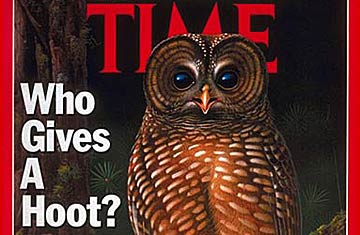
(5 of 9)
The controversy is on everyone's mind there, and the owl gets much of the blame. A banner headline in the local paper declared: SAVING SPOTTED OWL SEEN AS THREAT TO SCHOOLS. Douglas County may lose more than $13 million a year in timber revenue that the Federal Government returns to the county to help pay for public administration, roads and schools. At the local Ford dealership, the only owls that are welcomed are those made out of ceramic, which stand on the roofline warding off swallows intent on building nests under the eaves. Cars and trucks are not selling. Too much uncertainty. Says salesman Bruce Goetsch: "We survived without the dinosaur. What's the big deal about the owl?"
At Bud's Pub in Roseburg, a spotted owl hangs in effigy over the bar. Shops offer T shirts saying I LOVE SPOTTED OWLS . . . FRIED. And in the cabin of logger Bill Haire's truck, beneath the mirror, swings a tiny owl with an arrow through its head. "I can still maintain some sense of humor," says Haire. His father Tom, 65, works with him in the forest, and his son Brian, 12, hopes one day to join them there. "If it comes down to my family or that bird," says Haire, "that bird's going to suffer. Where would we be right now if everything that lived on this earth still survived -- the saber-toothed tiger, the woolly mammoth? Things adapt or they become extinct." That applies to his industry as well, says Haire. "If we don't adapt, we'll become extinct."
The crisis has forced many in Douglas County to reappraise a life-style more precious now that it is endangered. Those who work in the woods can make $35,000 to $45,000 a year. Millworkers generally make less. But the issue is more than money. They have also been forced to re-examine themselves and the ecological legacy they have been left. Douglas County has always been dependent on natural resources, though it has not always used them prudently. In the 19th century, furriers killed off many of the furbearing animals and, in so doing, their trade as well. Later, prospectors emptied the rivers of gold, and the mining camps were reclaimed by the forest. Millworkers and their families often ask union leader Burson what will become of them. "What do I tell them, 'It's going to be O.K.'?" asks Burson. "I can't. Who do I blame? Do I blame the industry for raping the lands in the East and raping the lands in the West 50 years ago and not replanting? Do I blame my father? Do I blame my grandfather? Do I blame myself for not reading the paper every single night and being critically involved in these issues? How do I answer these people?"
Mill town after mill town is buried beneath an avalanche of contradictory statistics tossed out by timber-industry officials and environmentalists. "To put it bluntly, we don't know what the hell is going on," says Burson. "We're being blackmailed and threatened from both sides. Industry is saying 'Support our side, or you'll lose your jobs.' Environmentalists are saying 'Support our side, or you won't have clean air to breathe.' People are scared to death."
